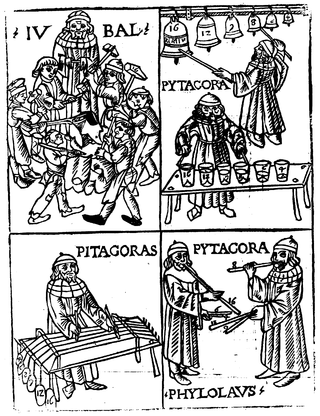Related Research Articles
Semiotics is the systematic study of sign processes (semiosis) and meaning-making. Semiosis is any activity, conduct, or process that involves signs, where a sign is defined as anything that communicates something, usually called a meaning, to the sign's interpreter. The meaning can be intentional, such as a word uttered with a specific meaning; or unintentional, such as a symptom being a sign of a particular medical condition. Signs can also communicate feelings and may communicate internally or through any of the senses: visual, auditory, tactile, olfactory, or gustatory (taste). Contemporary semiotics is a branch of science that studies meaning-making and various types of knowledge.

Music theory is the study of the practices and possibilities of music. The Oxford Companion to Music describes three interrelated uses of the term "music theory": The first is the "rudiments", that are needed to understand music notation ; the second is learning scholars' views on music from antiquity to the present; the third is a sub-topic of musicology that "seeks to define processes and general principles in music". The musicological approach to theory differs from music analysis "in that it takes as its starting-point not the individual work or performance but the fundamental materials from which it is built."

Musical analysis is the study of musical structure in either compositions or performances. According to music theorist Ian Bent, music analysis "is the means of answering directly the question 'How does it work?'". The method employed to answer this question, and indeed exactly what is meant by the question, differs from analyst to analyst, and according to the purpose of the analysis. According to Bent, "its emergence as an approach and method can be traced back to the 1750s. However it existed as a scholarly tool, albeit an auxiliary one, from the Middle Ages onwards."

The emancipation of the dissonance was a concept or goal put forth by composer Arnold Schoenberg and others, including his pupil Anton Webern. The phrase first appears in Schoenberg's 1926 essay "Opinion or Insight?". It may be described as a metanarrative to justify atonality. The musicologist Jim Samson describes:
As the ear becomes acclimatized to a sonority within a particular context, the sonority will gradually become 'emancipated' from that context and seek a new one. The emancipation of the dominant-quality dissonances has followed this pattern, with the dominant seventh developing in status from a contrapuntal note in the sixteenth century to a quasi-consonant harmonic note in the early nineteenth. By the later nineteenth century the higher numbered dominant-quality dissonances had also achieved harmonic status, with resolution delayed or omitted completely. The greater autonomy of the dominant-quality dissonance contributed significantly to the weakening of traditional tonal function within a purely diatonic context.

In music, a motif IPA: (/moʊˈtiːf/) is a short musical idea, a salient recurring figure, musical fragment or succession of notes that has some special importance in or is characteristic of a composition. The motif is the smallest structural unit possessing thematic identity.

In music, a subject is the material, usually a recognizable melody, upon which part or all of a composition is based. In forms other than the fugue, this may be known as the theme.

Music can be analysed by considering a variety of its elements, or parts, individually or together. A commonly used list of the main elements includes pitch, timbre, texture, volume, duration, and form. The elements of music may be compared to the elements of art or design.

Eero Aarne Pekka Tarasti, is a Finnish musicologist and semiologist, currently serving as Professor Emeritus of Musicology at the University of Helsinki.

Jean-Jacques Nattiez is a musical semiologist or semiotician and professor of musicology at the Université de Montréal. He studied semiology with Georges Mounin and Jean Molino and music semiology (doctoral) with Nicolas Ruwet.
Jean Molino is professeur ordinaire at the University of Lausanne and a semiologist. His former students include Jean-Jacques Nattiez.
Esthesic and poietic are terms used in semiotics, the study of signs, to describe perceptive and productive levels, processes, and analyses of symbolic forms. The corresponding terms for the processes are esthesis and poiesis.
In semiotics the neutral level of a sign is the "trace" left behind; the physical or material creation or remains of esthesic and poietic processes, levels, and analyses of symbolic forms. A part of all signs according to a tri-partitional definition, it corresponds to Saussure's "sound-image".

The 1957 Encyclopédie Larousse defines a cell in music as a "small rhythmic and melodic design that can be isolated, or can make up one part of a thematic context". The cell may be distinguished from the figure or motif: the 1958 Encyclopédie Fasquelle defines a cell as "the smallest indivisible unit", unlike the motif, which may be divisible into more than one cell. "A cell can be developed, independent of its context, as a melodic fragment, it can be used as a developmental motif. It can be the source for the whole structure of the work; in that case it is called a generative cell."
In Western music theory, the term sentence is analogous to the way the term is used in linguistics, in that it usually refers to a complete, somewhat self-contained statement. Usually a sentence refers to musical spans towards the lower end of the durational scale; i.e. melodic or thematic entities well below the level of movement or section, but above the level of motif or measure. The term is usually encountered in discussions of thematic construction. In the last fifty years, an increasing number of theorists such as William Caplin have used the term to refer to a specific theme-type involving repetition and development.
In music cognition and musical analysis, the study of melodic expectation considers the engagement of the brain's predictive mechanisms in response to music. For example, if the ascending musical partial octave "do-re-mi-fa-sol-la-ti-..." is heard, listeners familiar with Western music will have a strong expectation to hear or provide one more note, "do", to complete the octave.
In semiotics, a code is a set of cultural conventions, contemporary sub-codes, and themes used to communicate meaning. The most common is one's spoken language, but the term can also be used to refer to any narrative form: consider the color scheme of an image, or the rules of a board game.
In semiotics, denotation is the surface or the literal meaning, the definition most likely to appear in a dictionary.
In semiotics, connotation arises when the denotative relationship between a signifier and its signified is inadequate to serve the needs of the community. A second level of meanings is termed connotative. These meanings are not objective representations of the thing, but new usages produced by the language group.
The term seriation [mise en série] was proposed for use in semiotics by Jean Molino and derived from classical philology. Seriation "invokes the idea that any investigator, in order to assign some plausible meaning to a given phenomenon, must interpret it within a series of comparable phenomena." One cannot interpret what philology calls a hapax; that is, an isolated phenomenon. Art historian Erwin Panofsky has explained the situation in very clear terms:
The following outline is provided as an overview of and topical guide to semiotics:
References
- ↑ Agawu 2008, [ page needed ].
- ↑ Middleton 1990, p. 172.
- ↑ Nattiez 1976.
- ↑ Nattiez 1987.
- ↑ Nattiez 1989.
- ↑ Stefani 1973.
- ↑ Stefani 1976.
- ↑ Baroni 1983.
- ↑ Semiotica 66 1987, 1–3.
- ↑ Barthes 1977.
- ↑ Barthes 1985.
- ↑ Barthes 1982, [ page needed ].
- ↑ Meyer 1989.
- ↑ Lerdahl and Jackendoff 1983.
Sources
- Agawu, Kofi (2008). Music as Discourse: Semiotic Adventures in Romantic Music. New York: Oxford University Press. ISBN 978-0-19-020640-6.
- Baroni, Mario (1983). "The Concept of Musical Grammar", translated by Simon Maguire and William Drabkin. Music Analysis 2, no. 2:175–208.
- Barthes, Roland (1977). Image, Music, Text, translated by Stephen Heath. New York : Hill and Wang. ISBN 9780809057405, 9780374521363.
- Barthes, Roland (1982). "The Eiffel Tower". In A Barthes Reader, edited, and with an introduction, by Susan Sontag, 236–250. New York: Hill and Wang. ISBN 9780809028153, 9780880290159, 9780374521448.
- Barthes, Roland (1985). The Responsibility of Forms: Critical Essays on Music, Art, and Representation, edited by Richard Howard. Oxford: Basil Blackwell; New York: Hill and Wang. ISBN 9780809080755, 9780809015221.
- Lerdahl, Fred, and Ray Jackendoff (1983). A Generative Theory of Tonal Music. Cambridge, Massachusetts: MIT Press[ ISBN missing ].
- Meyer, Leonard B. (1989). Style and Music: Theory, History, and Ideology. Chicago: University of Chicago Press. ISBN 9780226521527.
- Middleton, Richard (1990). Studying Popular Music. Milton Keynes and Philadelphia: Open University Press. ISBN 9780335152766 (cloth); ISBN 9780335152759 (pbk).
- Nattiez, Jean-Jacques (1976). Fondements d'une sémiologie de la musique. Collection Esthétique. Paris: Union générale d'éditions. ISBN 9782264000033.
- Nattiez, Jean-Jacques (1987). Musicologie générale et sémiologie. Collection Musique /Passé/Présent. Paris: C. Bourgois. ISBN 9782267005004
- Nattiez, Jean-Jacques (1989). Proust as Musician, translated by Derrick Puffett. Cambridge and New York: Cambridge University Press. ISBN 978-0-521-36349-5 (cloth); ISBN 978-0-521-02802-8.
- Semiotica 66 (1987).[ full citation needed ].
- Stefani, Gino (1973). "Sémiotique en musicologie". Versus 5:20–42.
- Stefani, Gino (1976). Introduzione alla semiotica della musica. Palermo: Sellerio editore.